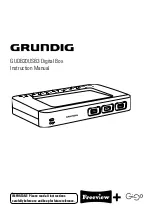
Circuit-, IC descriptions and list of abbreviations
EN 130
LX7500R
9.
The Video-I/O-switching is basically realized by the matrix
switch STV6618 [7408], which is controlled via I
2
C-bus by the
CC. All used outputs excluding pin 21 (Y/CVBS-REC) have a
6dB-amplification and a 75 Ohms-driver-stage inside. This IC
also includes several digital outputs, which are used for
switching purposes on the analog board. The record selector
inside the switch selects between the CVBS from frontend, the
CVBS from Cinch-Rear or Y from the S-Video-input rear.
Afterwards the signal passes another switch [7411] in which a
selection between signals from the front or the preselected
ones is done. The output signals of [7411] are fed as
“A_YCVBS”- and “A_C”-line to the digital board for further
processing.
To reduce the number of external presets there is only one
station for CVBS or Y/C (front and rear). The set automatically
detects between the two inputs depending on the presence of
a video signal (sync separator-circuit on
µ
P-sub-board) where
Y/C has higher priority.
The Y/U/V-inputs are routed over the optional EPG board to the
digital PCB. Only the Y-line has to be present additionally on
pin 4 of [7408] for video recognition. Also all other video signal
from the analog board are routed through the EPG board if
present.
The signals “D_C” and “D_Y” are fed through [7408] (6dB
amplification) and via [7406], [7409] used as driver to the S-
Video output connector. The “D_CVBS” line is directly routed to
the modulator and via the circuit around [7431] and [7432]
amplified by 6dB before it is fed to the CVBS output plug. In
case of EPG the signals from the digital board are routet
through the EPG board where the selection between digital
board video or EPG OSD is taken.
The Y/U/V signals from the digital board are also passing
[7408] for 6dB amplification and driving purpose.
To achieve optimal picture quality the set is equipped with a
simple progressive scan function based on a so-called line
doubler. The complete generation of the signal is done on the
digital board and via a separate cable and connector [1946] the
corresponding Y/U/V lines are routed to the analog PCB. Also
the YUVprogressive signals are switchable to EPG OSD on the
EPG board if implemented. As there is only one Y/U/V output
available a switching between interlaced and progressive
output is necessary. While the transistors [7421], [7422],
[7424], [7425], [7427] and [7428] are used as driver for Y/U/V
progressive, [7423], [7426] and [7429] together with [7405] are
necessary for killing these signals via pin 42 of [7408] in case
the interlaced is selected (“PSCAN_KILL”-line set to low). If
progressive output is active the pins 27, 29 and 31 of [7408] are
set to high impedance and “PSCAN_KILL” is also high (e.g.
5V).
The detection of the picture ratio information on the Y/C inputs
(rear or front) is done by measuring the DC-level on the
Chroma signal via an analog input of the CC-P (“WSRI”- and
“WSFI”-line). In case the level is higher than 3,5V the input
signal is a 16:9 source, if the level is lower than 2,4V the picture
ratio is 4:3.
For generation of the appropriate DC-voltage on the Y/C output
the “WSRO”-line is controlled via pin18 of [7408] by the CC-P
(Pin 18 set to low means 4:3, pin 18 set to high determines
16:9).
During Stand-By there is also no loop-through of any input to
any output performed.
9.5
Digital Board Chrysalis F
9.5.1
Introduction
Block diagram 2nd generation DVD recorder
Figure 9-4
This 2nd generation Digital Board is based on the highly
integrated 'Chrysalis' IC. Its predecessors, the 'Empire' and
'Empress' based boards, had two PWBs mounted on top of
each other (due to separate DVIO board). For this new
generation, all functionality is now available on one PWB in one
BGA IC (Ball Grid Array) i.s.o. four VLSI ICs.
The board encodes and multiplexes analogue video and digital
uncompressed audio (I2S) into an MPEG2 stream. This
MPEG2 stream is formatted, to be recorded by the DVD+RW
engine. In playback, the board will decode the MPEG2 stream
into analogue and digital audio and into analogue video. In
addition, a DV stream can be received via IEEE1394 (i-Link),
and transformed to MPEG2 format.
There are versions foreseen, to generate a progressive scan
analogue video output. In the standard Chrysalis board, the
progressive video output is generated by the PNX7100. In the
Chrysalis 'F' it is generated by the Faroudja FLi2301.
The Chrysalis Digital board is pin compatible with the Empress
digital board in terms of A/V IO, BE interface, Power Supply,
and Service interface. For functional enhancements, several
connectors are added:IDE connector (HDD, AV3, PCMCIA,
etc.).
ANALOG BOARD
CONTROL
VIDEO IN/OUT
DISPLAY &
CONTROL BOARD
BASIC ENGINE
POWER SUPPLY
DIGITAL BOARD
DV IN
AUDIO IN/OUT
2FH VIDEO OUTPUT
CONTROL
CL 36532004_001.eps
140203
















































